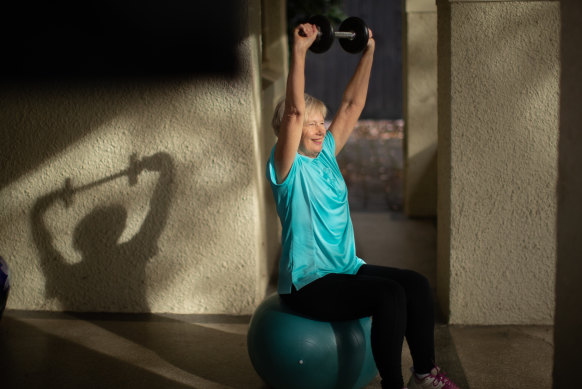This was published 3 years ago
The exercise older Australians need to incorporate into their day
Improved balance, denser bones and stronger joints are just some of the life-changing benefits that come with strength-based exercise in seniors. But with older Australians urged to be extra vigilant with social distancing measures, health experts are warning that if they don't work their muscles during the pandemic, their strength is at risk of wasting away.
“People are spending long periods indoors, probably involving long periods of sitting and doing little activity. That in itself creates problems,” says Professor Robin Daly, chair of exercise and ageing at Deakin University.

Anne Varley, 71, has been continuing her strength training.Credit: Simon Schluter
That’s because muscle mass deterioration begins in your 40s and accelerates from your 60s, Daly says. And inactivity is particularly detrimental, he warns, with research showing that 10 days of bed rest can lead to the equivalent of 10 years of muscle loss in older people.
Even in healthy adults aged 60 years and older, every one hour increase in daily sitting time is linked to a 33 per cent higher risk of having low muscle mass, Daly says.
“It’s absolutely critical in this period to not start to experience loss in muscle mass, strength and function. Muscle is largely under-appreciated for its role in health and disease,” Daly says. “So exercise is [crucial], particularly as we age.”
As well as reducing the risk of fractures and illness, Daly says muscle helps maintain the mobility of older Australians, enabling them to continue everyday activities such as walking to the supermarket, using stairs or getting out of a chair safely.
Daly’s big message for seniors is to introduce regular strengthening and balance activities into their day. “Walking is great for cardiovascular health but it won’t necessarily maintain your muscle,” he says.
Bill Dooley, an exercise scientist who trains clients above the age of 60, has been particularly worried about the potential for increased risk of falls from muscle loss during the COVID-19 crisis.
“Strength and balance are quite closely related,” Dooley says. “Weeks or months [of inactivity] in isolation could really set them back.”
It’s why Dooley has been posting short instructional videos on his Facebook page, Growing Young Exercise Program, to teach older Australians basic exercises they can do at home daily without equipment.
For those new to strength workouts, Dooley recommends starting with a squat that involves repeatedly sitting and standing from a chair. He also suggests trying kick-backs, which involve resting one hand on a wall side-on and slowly swinging the legs, one at a time, backwards. Both of these exercises will aid leg strength. He recommends beginning with 10 repetitions of each exercise.
For upper body, he recommends doing push-ups upright against a wall, or grabbing a couple of soup cans for shoulder presses and bicep curls.
For balance, standing in a heel-to-toe position for 30 seconds is a good beginner activity.
Melbourne grandmother Anne Varley, 71, credits strength training with helping her continue to enjoy her favourite activities, such as bushwalking, golfing and gardening. She has made an effort to continue to train twice a week while stuck at home.
“We are living longer… and in order to enjoy all the things we do, like travel or walking or caring for our grandchildren, we have to be as fit as we’re able to be and as strong as we’re able to be.”
While Australian guidelines recommend a minimum of 150 minutes per week of moderate intensity exercise, Daly says 30 minutes per day can feel daunting for older people starting out. Instead, he recommends “exercise snacking” – so short bursts of activity each day – because starting with several two-minute stints is more achievable and will interrupt prolonged sitting.